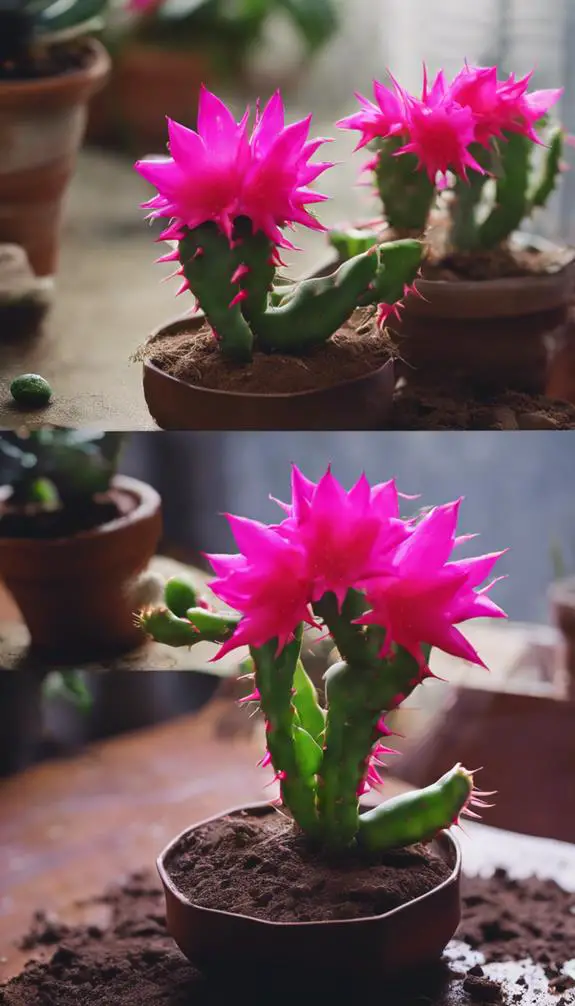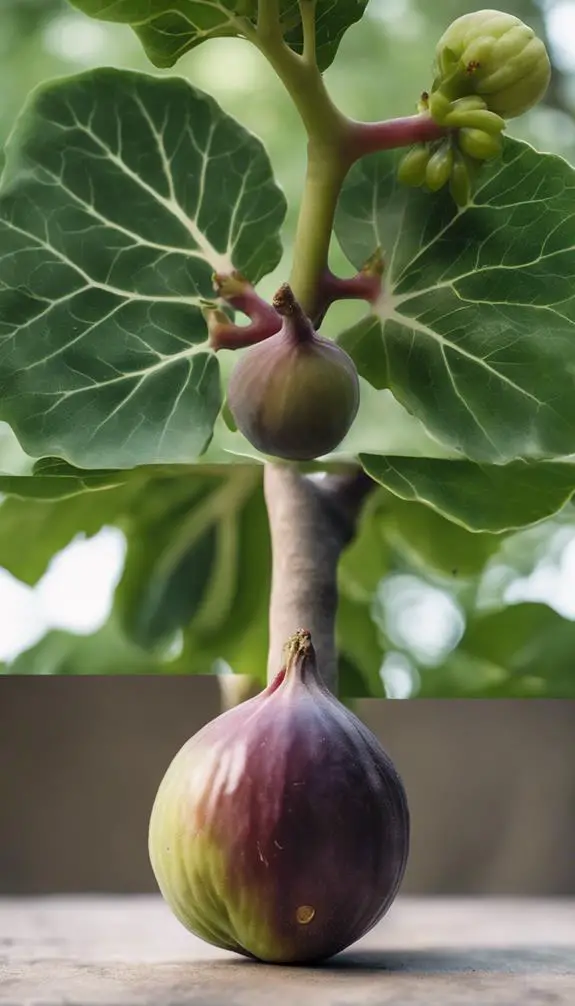You're anxious to grow your own fig tree, but where do you start? Selecting the right parent tree is vital, as it'll determine the quality of your new tree. Look for a mature, robust tree with a sturdy trunk, well-balanced canopy, and abundant fruit production. Once you've found the perfect parent, you'll need to take cuttings – but what's the best way to do it? Should you take cuttings from the tip of a branch or from elsewhere on the tree? And what about rooting hormone – is it really necessary? You're about to find out.
Summary
- Select a mature and robust parent tree with desirable traits, at least 3-5 years old, with a sturdy trunk and well-balanced canopy.
- Take 6- to 8-inch cuttings from the tip of a mature branch, making a clean cut just above a node, and dip the cut end in rooting hormone.
- Plant the cutting in a well-draining potting mix, gently firming the soil around it, and maintain consistent moisture for optimal results.
- Create a humid microclimate by covering the propagation area with a clear plastic bag or cloche, maintaining 80-90% relative humidity.
- Provide fig trees with at least six hours of direct sunlight per day, consistent temperatures between 65°F and 75°F, and balanced nutrition for healthy growth.
Choosing the Right Fig Variety
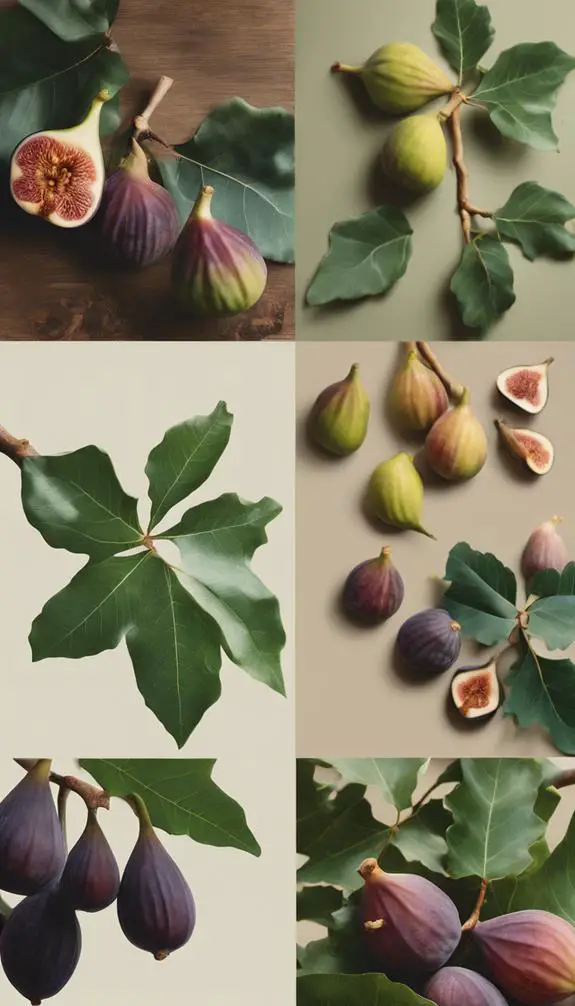
When selecting a fig tree variety, you're not just picking a tree – you're choosing a partner for a long-term relationship that requires careful consideration.
With fig popularity on the rise, it's crucial to understand the rich fig history that has led to the diverse range of varieties available today.
From the sweet, jam-like flavor of Brown Turkey to the compact growth habit of Dwarf Washington, each variety has its unique characteristics.
Consider factors like climate tolerance, fruit production, and disease resistance when making your selection.
Preparing the Propagation Area
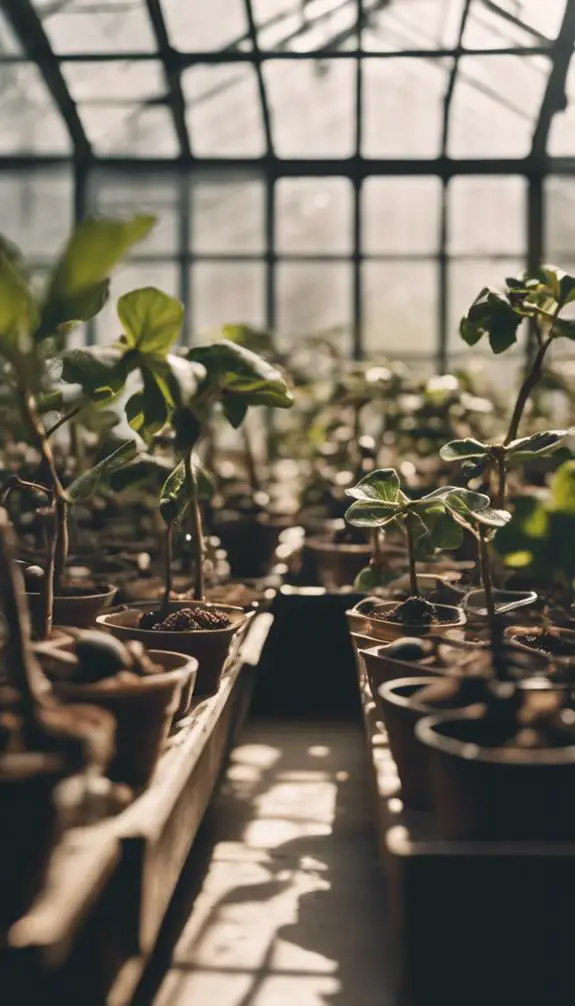
Frequently, would-be fig tree propagators overlook the pivotal step of preparing the propagation area, only to face disappointment later on.
You won't make the same mistake, though. To guarantee success, you'll need a clean workspace.
Clear the area of any debris, and sanitize the surface with a gentle disinfectant.
Next, gather your sterile tools – a sharp, clean knife or pruning shears and a small pot filled with a well-draining seed starting mix.
Sterilize your tools by soaking them in a solution of one part bleach to nine parts water for 10-15 minutes.
Rinse thoroughly and let them air dry.
With your propagation area prepared, you're ready to take the next step in propagating your fig tree.
Taking Fig Tree Cuttings

With your propagation area prepared, you're ready to collect fig tree cuttings.
For successful fig cultivation, it's crucial to use cutting techniques that promote healthy root development.
Take 6-8 inch cuttings from the tips of vigorous branches, making clean cuts just above a node using sharp, sterile pruning tools. Remove lower leaves, leaving only two or three at the top.
Dip the cut end in rooting hormone to stimulate root growth. You can also air-layer the cuttings by making a small incision on the stem, wrapping it with moist moss, and securing it with twine. This technique increases the chances of successful propagation.
Selecting Healthy Parent Trees

You'll want to choose parent trees that are mature and robust, as these will provide the best chance of successful propagation.
Look for trees that are at least 3-5 years old and have a sturdy trunk with a diameter of around 1-2 inches.
Healthy parent trees will also exhibit signs of vigor, such as lush green leaves, abundant fruit production, and a well-balanced canopy.
Tree Age and Size
Selecting a healthy parent tree is crucial for successful fig tree propagation.
When choosing a parent tree, consider its age and size. A mature fig tree, typically between 5-10 years old, is ideal for propagation.
At this stage, the tree has reached peak fig maturity, producing high-quality fruit with desirable traits. Look for a tree with a sturdy tree stature, around 6-10 feet tall, with a well-developed root system.
This guarantees the parent tree is robust enough to support the energy demands of fruit production and propagation. By selecting a parent tree with these characteristics, you'll increase the chances of producing healthy, thriving fig trees with desirable traits.
Fig Tree Health Signs
When inspecting a potential parent fig tree, pay attention to its overall health and vigor, as these traits will directly impact the quality of the propagated trees.
A healthy fig tree typically exhibits robust growth, a dense canopy, and a well-developed root system. Look for signs of fig tree liveliness, such as lush green leaves, plump fruits, and a sturdy trunk.
On the other hand, tree stress signals like yellowing leaves, premature defoliation, or cankered branches indicate poor health. Avoid selecting parent trees with these signs, as they may pass on their weaknesses to the propagated trees.
Rooting Fig Tree Cuttings

Frequently, fig tree enthusiasts turn to rooting fig tree cuttings as a reliable method for propagating new trees.
You'll want to take 6- to 8-inch cuttings from the tip of a mature branch, making a clean cut just above a node. Remove lower leaves, leaving only two or three at the top, and dip the cut end in rooting hormone to stimulate fig propagation.
Plant the cutting in a well-draining potting mix, gently firming the soil around it. Water thoroughly and maintain consistent moisture. With ideal conditions, you can expect a high rate of rooting success.
Monitor your cuttings closely, as they'll require regular pruning to promote healthy growth and development. By following these steps, you'll be well on your way to successfully propagating new fig trees.
Creating a Humid Microclimate
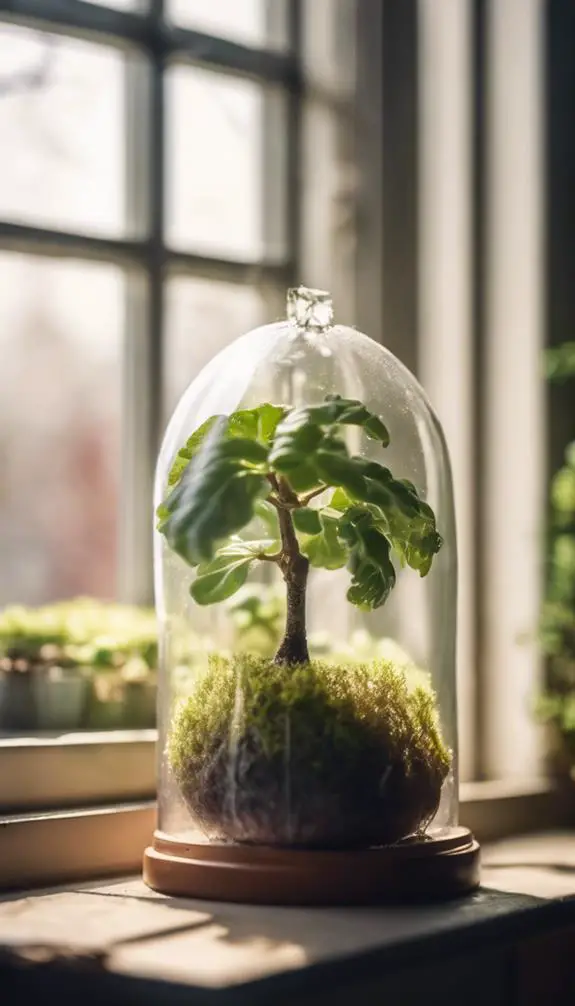
You'll increase your chances of successful propagation by creating a humid microclimate, which can be achieved through various methods.
You can set up a humidity chamber using a clear plastic bag or a cloche to maintain high humidity levels around your cuttings.
Microclimate Creation Methods
Creating a humid microclimate is essential for propagating fig trees, as these plants thrive in environments with high moisture levels.
You'll want to create a sheltered environment that protects your cuttings from harsh winds and extreme temperatures.
Climate control is key in maintaining a humid microclimate.
You can achieve this by using a cloche or a cold frame to cover your propagation area.
These structures will trap moisture and maintain a consistent temperature, creating an ideal environment for your fig cuttings to root.
Humidity Chamber Setup
A propagation tray or small greenhouse serves as the foundation for your humidity chamber, providing a contained space to maintain high moisture levels.
This setup allows you to control the environment and optimize conditions for your fig tree cuttings. When designing your chamber, consider the size and material.
A clear plastic or polycarbonate cover will help maintain humidity and allow for light penetration. Guarantee the chamber is well-ventilated to prevent the buildup of condensation, which can lead to fungal diseases.
Implement a humidity control system, such as a misting system or a humidifier, to maintain a consistent relative humidity of 80-90%. This will create an ideal environment for root development and increase the chances of successful propagation.
Providing Adequate Light

Most fig trees require at least six hours of direct sunlight per day to thrive, and some varieties need even more.
As you set up your propagation area, guarantee you provide adequate light intensity. South-facing windows are ideal, as they receive the most direct sunlight.
If this isn't possible, east- or west-facing windows can also work. Avoid placing your fig trees near north-facing windows, as they receive limited direct sunlight.
Consider using grow lights to supplement natural light if necessary. Be mindful of window orientation and adjust your setup accordingly.
Maintaining Optimal Temperature

You'll want to keep your fig tree in an area with a consistent temperature between 65°F and 75°F (18°C and 24°C), as this ideal range promotes healthy growth and fruit production.
Temperature fluctuations can cause stress, leading to disease and pests, so it's crucial to maintain a stable environment. By doing so, you'll create a perfect setting for your fig tree to thrive.
Ideal Temperature Range
Fig trees thrive in environments where the temperature is carefully regulated, as even slight fluctuations can impact their growth and fruit production.
You'll want to guarantee your fig tree is exposed to an ideal temperature range of 65°F to 75°F (18°C to 24°C) during the day and no lower than 55°F (13°C) at night. This temperature tolerance allows for peak growth and fruiting.
Effective temperature monitoring is vital, as temperatures outside this range can lead to stress and reduced yields. By maintaining a stable temperature environment, you'll be able to promote healthy growth and maximize your fig tree's potential.
Temperature Fluctuation Effects
Your fig tree's response to temperature fluctuations can be dramatic, with even slight deviations from the ideal range triggering a cascade of negative effects.
As a propagator, you should be aware that temperature sensitivity is a critical factor in fig tree development. When your tree is exposed to cold shock, it can lead to reduced growth rates, decreased fruit production, and increased susceptibility to disease.
Even mild temperature fluctuations can cause stress, making your tree more vulnerable to pests and pathogens. By understanding the impact of temperature fluctuations, you can take proactive measures to mitigate these effects and create a favorable environment for your fig tree to thrive.
Stable Temperature Maintenance
Maintain a consistent temperature between 65°F and 75°F (18°C and 24°C) to create an ideal environment for your fig tree's growth and development.
This stable temperature range allows your tree to focus its energy on root growth, leaf production, and fruiting.
To achieve this, implement climate control measures, such as using heaters, air conditioners, or shades, depending on your location and climate.
Effective temperature regulation is vital, as it prevents stress and promotes healthy growth.
By maintaining a consistent temperature, you're creating a perfect environment for your fig tree to thrive.
Watering and Humidity Control

Soil moisture levels play a critical role in the health and development of fig trees, and getting the balance just right can be a delicate task.
You'll want to avoid waterlogged soil, which can lead to root rot and other issues. Instead, aim for a consistent moisture level that's neither too wet nor too dry.
Morning misting can be an effective way to maintain humidity and provide your fig tree with the moisture it needs.
Be cautious not to overwater, especially in the early stages of propagation. A general rule of thumb is to water only when the top inch of soil feels dry to the touch.
Fertilizing New Fig Trees

Having established the ideal moisture levels for your fig tree, you can now turn your attention to providing it with the necessary nutrients for growth.
Fig trees require a balanced diet of fig nutrients to thrive, which can be achieved through strategic soil amendments.
Start by applying a slow-release fertilizer during the growing season, typically in early spring and mid-summer. This will provide your tree with a steady supply of essential macronutrients like nitrogen, phosphorus, and potassium.
Additionally, consider adding organic matter like compost or well-rotted manure to improve soil structure and fertility.
Pruning for Air Circulation

Air circulation is essential for fig trees, as it helps prevent disease and promotes healthy growth.
When pruning your fig tree, you'll want to focus on creating air pockets to facilitate airflow. This can be achieved by using pruning techniques that remove select branches, allowing air to circulate through the tree's canopy.
Start by identifying areas where branches are touching or growing too close together, and remove the weaker of the two. This will create space for air to move through and reduce the risk of disease.
Transplanting Fig Trees Outdoors
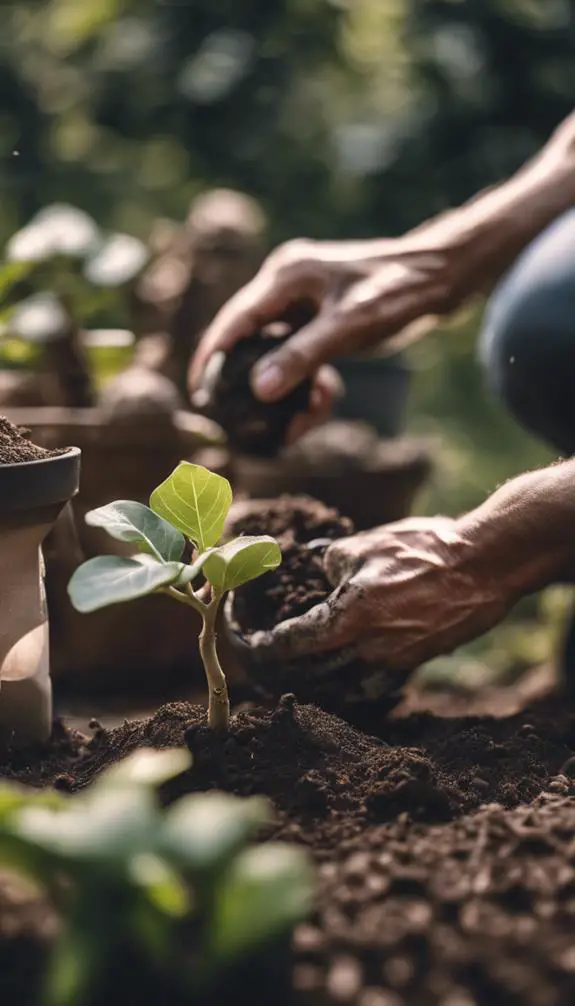
With your fig tree pruned for ideal air circulation, it's now ready to thrive in its permanent outdoor location.
Before transplanting, confirm proper soil preparation by mixing in organic matter like compost or manure to improve drainage and fertility.
Dig a hole twice as wide and as deep as the root ball. Gently remove the tree from its container, taking care not to disturb the roots.
Place the tree in the hole, backfilling with prepared soil. Water thoroughly to settle the soil.
For outdoor acclimation, provide partial shade for the first week, then gradually increase sunlight exposure.
Monitor soil moisture, adjusting your watering schedule as needed.
Common Propagation Mistakes

Propagating fig trees requires attention to detail, as even slight mistakes can hinder the tree's growth or lead to its demise.
You may experience propagation anxiety when your efforts don't yield the desired results, leading to failed expectations.
One common mistake is overwatering, which can cause root rot and kill the tree. Underwatering, on the other hand, can lead to stunted growth.
You must also avoid poor pruning techniques, which can stress the tree and reduce its chances of survival.
Additionally, failing to provide adequate light and nutrients can impede the tree's development.
FAQs
Can I Propagate Fig Trees From Seed Instead of Cuttings?
You can try propagating fig trees from seed, but be aware that seed viability is low and fig tree genetics are complex, resulting in unpredictable offspring that may not retain desirable traits, making cuttings a more reliable option.
How Long Does It Take for Fig Trees to Produce Fruit?
You'll need fig tree patience, as it typically takes 2-5 years for a newly planted tree to produce fruit, with ideal conditions and proper care, yielding a bountiful harvest, but the fruit production timeline can vary depending on factors like climate and cultivar.
Can I Grow Fig Trees in Containers Permanently?
You can grow fig trees in containers permanently, leveraging advantages like increased mobility and soil control, but guarantee you provide well-draining soil with a pH between 6.0 and 6.5, and a balanced fertilizer regimen.
Are Fig Trees Susceptible to Pests and Diseases?
You'll need to monitor your fig trees for Fig tree mites, which can cause yellowing leaves, and prevent Root rot issues by ensuring good drainage and avoiding overwatering, as these pests and diseases can substantially impact your tree's health.
Can I Propagate Fig Trees in the Winter Months?
You can attempt winter propagation, but fig trees' winter hardiness varies; for best results, collect cuttings in late fall, store them in cold storage, and plant in early spring when temperatures rise, ensuring ideal root development.
Conclusion
You've successfully propagated a fig tree. Now, monitor its progress, ensuring it receives adequate light, water, and nutrients. Transplant it outdoors when it's around 6-12 inches tall, choosing a location with full sun and well-draining soil. Continue pruning to maintain air circulation and promote healthy growth. With proper care, your new fig tree will thrive, producing delicious fruit for years to come.



